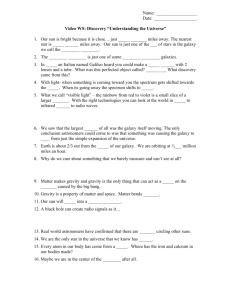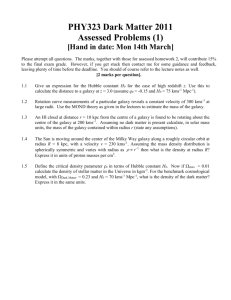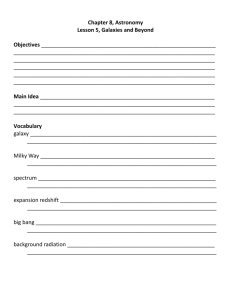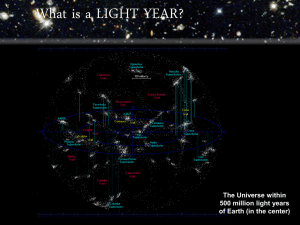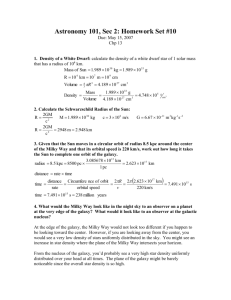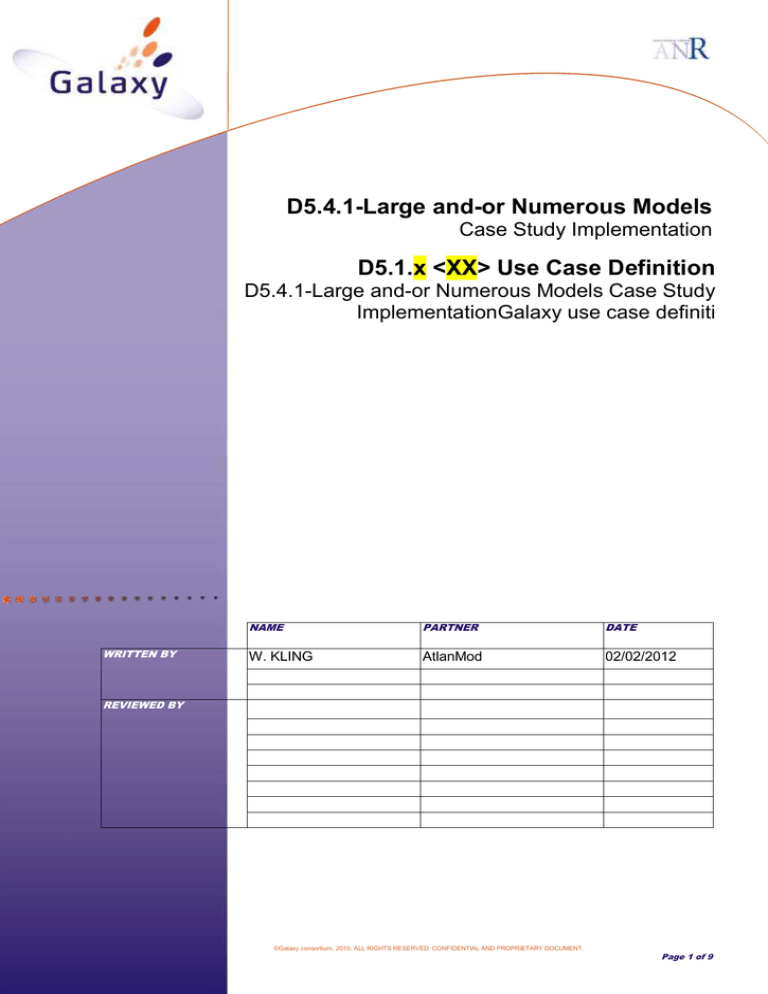
D5.4.1-Large and-or Numerous Models
Case Study Implementation
D5.1.x <XX> Use Case Definition
D5.4.1-Large and-or Numerous Models Case Study
ImplementationGalaxy use case definiti
WRITTEN BY
NAME
PARTNER
DATE
W. KLING
AtlanMod
02/02/2012
REVIEWED BY
©Galaxy consortium, 2010. ALL RIGHTS RESERVED. CONFIDENTIAL AND PROPRIETARY DOCUMENT.
Page 1 of 9
Galaxy
D5.4.1-Large and-or Numerous Models
PROJECT: GALAXY
REFERENCE: D5.4.1
ISSUE:
1.0 Draft1
Case Study Implementation
RECORD OF REVISIONS
ISSUE
DATE
EFFECT ON
PAGE
02/02/2012
ARPEGE 2009
DATE:
25/02/2010
REASONS FOR REVISION
PARA
Document creation
©Galaxy consortium, 2010. ALL RIGHTS RESERVED. CONFIDENTIAL AND PROPRIETARY DOCUMENT.
Page 2 of 9
Galaxy
D5.4.1-Large and-or Numerous Models
PROJECT: GALAXY
REFERENCE: D5.4.1
ISSUE:
1.0 Draft1
Case Study Implementation
ARPEGE 2009
DATE:
25/02/2010
TABLE OF CONTENTS
1. INTRODUCTION
5
1.1
GOAL OF THIS DOCUMENT
5
1.2
DOCUMENT ORGANIZATION
5
2. SCOPE
6
2.1
DESCRIPTION OF THE WEBML METAMODEL
ERROR! BOOKMARK NOT DEFINED.
2.2
SCOPE OF THE STUDY
ERROR! BOOKMARK NOT DEFINED.
3. VALIDATION METHOD
ERROR! BOOKMARK NOT DEFINED.
4. INVOLVED PARTNERS
ERROR! BOOKMARK NOT DEFINED.
5. VALIDATION SCENARIOS
5.1
8
REPRESENTATION OF COMPLEX MODELS RELATIONS AND ITS AUTOMATIC
DISCOVERY
8
5.2
GATHERING METRICS FROM MULTIPLE MODELS
8
5.3
SELECTIVE MODEL TRANSFORMATION EXECUTION
8
6. INVOLVED MODELS
ERROR! BOOKMARK NOT DEFINED.
7. TOOLS USED
9
©Galaxy consortium, 2010. ALL RIGHTS RESERVED. CONFIDENTIAL AND PROPRIETARY DOCUMENT.
Page 3 of 9
Galaxy
D5.4.1-Large and-or Numerous Models
PROJECT: GALAXY
REFERENCE: D5.4.1
ISSUE:
1.0 Draft1
Case Study Implementation
TABLE OF APPLICABLE DOCUMENTS
N°
TITLE
REFERENCE
ISSUE
DATE
ARPEGE 2009
DATE:
25/02/2010
SOURCE
SIGLUM
NAME
A1
A2
A3
A4
TABLE OF REFERENCED DOCUMENTS
N°
TITLE
R1 Galaxy glossary
R2 Goal and metrics document
R3 Architecture specification
R4
REFERENCE
ISSUE
D1.2.2
D1.1
D4.1
ACRONYMS AND DEFINITIONS
Except if explicitly stated otherwise the definition of all terms and acronyms provided in [R1] is applicable in
this document. If any, additional and/or specific definitions applicable only in this document are listed in the
two tables below.
Acronymes
ACRONYM
DESCRIPTION
Definitions
TERMS
DESCRIPTION
©Galaxy consortium, 2010. ALL RIGHTS RESERVED. CONFIDENTIAL AND PROPRIETARY DOCUMENT.
Page 4 of 9
Galaxy
D5.4.1-Large and-or Numerous Models
Case Study Implementation
PROJECT: GALAXY
REFERENCE: D5.4.1
ISSUE:
1.0 Draft1
ARPEGE 2009
DATE:
25/02/2010
1. INTRODUCTION
One of the goals of the Galaxy project is to provide a conceptual and technical solution to deal with
large amounts of models effectively specifically regarding to models transformations of complex
and heterogeneous models arrangements. This technical solution has been envisioned as a
textual domain specific language (DSL) called MoScript, which has been specified and
implemented as a prototype described in D4.5.2 - Megamodel for transformations prototype.
In order to validate the technical solution, a set of use cases have been design, and implemented
to be executed with MoScript. This uses cases enable the MoScript validation in terms of
functionality. The goal is to show how certain models manipulations may be performed with less
effort and in a more consistent model driven oriented way than with current approaches.
1.1
GOAL OF THIS DOCUMENT
A specific task of the Galaxy project (T5.1) is dedicated to the definition of the use cases. This
document is a product of this task, which describes the D5.4.1 Large and-or Numerous Models
study case.
1.2
DOCUMENT ORGANIZATION
The chapter 2 describes the context of the tests cases and explains how are them valuable for
verifying the added value of MoScript to the Galaxy platform.
Chapter 3 describes the scenarios being used to assess the effort reduction for understanding and
manipulating repositories of large numbers of models.
Chapter 4 describes the technical environment and tools used in the elaboration and execution of
the test cases.
©Galaxy consortium, 2010. ALL RIGHTS RESERVED. CONFIDENTIAL AND PROPRIETARY DOCUMENT.
Page 5 of 9
Galaxy
D5.4.1-Large and-or Numerous Models
Case Study Implementation
PROJECT: GALAXY
REFERENCE: D5.4.1
ISSUE:
1.0 Draft1
ARPEGE 2009
DATE:
25/02/2010
2. SCOPE
The use cases proposed in this document aim to validate MoScript, a DSL for querying and
manipulating model repositories, as a proper contribution for addressing the problems of scalability
due to the large numbers of models and heterogeneity of development environments found in the
development and maintenance of model driven complex systems.
Before going ahead with the environment description, it is important to make clear that for testing
MoScript we are interested in the structure and physical characteristics of the model repository
more than the system that is represented by the models in the repository.
For the purpose of this deliverable, we choose a WebML [1] project and the ATL transformation
Zoo as testbed for validating that MoScript can help users to deal effectively with large amounts of
complex and interrelated models.
WebML is a domain specific language and web applications design methodology mainly targeted
for model driven design and development of data intensive Web applications i.e. web sites for
accessing and maintaining large amounts of structured data usually stored in RDBMS.
WebML is implemented by the privative WebRatioTM tool, which is able to generate fully functional
applications from WebML diagrams and is free for teaching and research purposes. WebML is
successfully proven DSLs for Model Driven Development for data intensive systems.
Depending on the size of the system represented by a WebML model, WebML models may range
from small to big (several Mb) models with hundred or thousands of components.
WebML projects count with the following characteristics that we find suitable to test MoScript:
Heterogeneity: Although WebML is considered to follow a MDD approach; the WebRatio
model editor stores the WebML model in a XML format with no reference to a predefined
XML schema or DTD. In order to manipulate the WebML model we need first to bridge from
the xmlware to a modelware [2] technical space.
Large amount and complex interrelations of models: Although a WebML model can be
seen as a single model, the WebRatio tool splits the WebML model in several sub models
each one with a well-defined purpose. This fact, enable us to see a WebML project as
model repository with complex interrelations.
The ATL transformation Zoo1 is large repository of models and ATL transformations. It counts also
with characteristics that make it suitable for testing MoScript:
Heterogeneity: As shown in Figure 1 the ATL Zoo counts with many model artefacts in
different formats, which reflects the same situation we are going to find in any model driven
complex system.
1
http://www.eclipse.org/m2m/atl/atlTransformations/
©Galaxy consortium, 2010. ALL RIGHTS RESERVED. CONFIDENTIAL AND PROPRIETARY DOCUMENT.
Page 6 of 9
Galaxy
D5.4.1-Large and-or Numerous Models
Case Study Implementation
PROJECT: GALAXY
REFERENCE: D5.4.1
ISSUE:
1.0 Draft1
ARPEGE 2009
DATE:
25/02/2010
Figure 1: ATL Transformation Zoo modelling artefacts distribution
Large amount and complex interrelations of models: The ATL Zoo counts with a total of
1704 modelling artefacts that all of them playing a specific role in the repository. From
them, 259 artefacts correspond to ATL transformations, all of them related to models and
metamodels and in some cases to other transformations by transformation chains.
©Galaxy consortium, 2010. ALL RIGHTS RESERVED. CONFIDENTIAL AND PROPRIETARY DOCUMENT.
Page 7 of 9
Galaxy
D5.4.1-Large and-or Numerous Models
Case Study Implementation
PROJECT: GALAXY
REFERENCE: D5.4.1
ISSUE:
1.0 Draft1
ARPEGE 2009
DATE:
25/02/2010
3. VALIDATION SCENARIOS
3.1
REPRESENTATION OF COMPLEX MODELS RELATIONS AND ITS AUTOMATIC
DISCOVERY
One of the complexities introduced by MDE is the inclusion of new artefacts in the development
process such as models, metamodels, transformations and the strong dependencies between
them. This characteristic combined with the fact that model driven complex systems usually require
large numbers of models to form up the system, makes this kind of systems difficult to understand
and thus not suitable for collaboration. In order to easily understand those systems we require
ways to view or query the complex model arrangements for extracting the information particular
interests.
MoScript proposes the use of a Megamodel as a view describing the models of complex systems
and its interactions, which may be queried in different way, facilitating the understanding of the
model repository representing the system. Nevertheless, before being able to query the
Megamodel, first it has to be populated. Each model, metamodel, transformation etc. and their
relations must be registered in it. Doing this task manually is time consuming and error prone.
In this scenario we demonstrate how MoScript facilitates the automation of the population of the
Megamodel through different features like the projection of existing artefacts as models to be able
to query their content for inferring its role in the repository, and by providing operations to populate
the megamodel with new model elements describing the repository artefacts.
Scenario description
3.2
GATHERING METRICS FROM MULTIPLE MODELS
Another characteristic of model driven collaborative systems is that developers may require to
conveniently navigate between several models and even to consider several models
simultaneously, for example to compare, align them or extract some kind of metrics from them.
MoScript allows the inspection of several models at the same time and thus the combination of
their information to extract convenient metrics from model repositories facilitating its understanding.
In this use case we demonstrate how is possible with MoScript to gather information from several
interrelated models of a big repository.
Scenario description
3.3
SELECTIVE MODEL TRANSFORMATION EXECUTION
Model driven collaborative systems are in constant evolution, although some of them can be
considered to be minor as they only impact one particular project or few components other
evolutions may be substantial impacting a large set of projects and components. Thus, developers
cannot rely on static views of the repository, neither use traditional scripts that do not evolve along
with the repository for executing model manipulations such as transformations.
MoScripts allows executing model manipulations according to the results of querying constantly
updated repository view. For instance, this means that the transformations to be executed may be
selected according to their content or the content of the models with which they are related etc.
This gives a great flexibility at the moment of manipulating models avoiding the constant update of
model manipulation scripts.
©Galaxy consortium, 2010. ALL RIGHTS RESERVED. CONFIDENTIAL AND PROPRIETARY DOCUMENT.
Page 8 of 9
Galaxy
D5.4.1-Large and-or Numerous Models
Case Study Implementation
PROJECT: GALAXY
REFERENCE: D5.4.1
ISSUE:
1.0 Draft1
ARPEGE 2009
DATE:
25/02/2010
In this use case, we show how is possible with MoScript to select the transformations to be
executed according to the content of the models.
Scenario description
4. TOOLS USED
ATL VM
AM3
MoScript prototype
5. REFERENCES
[1]
Marco Brambilla, Sara Comai, Piero Fraternali and Maristella Matera, Designing Web
Applications with Webml and Webratio in Web Engineering: Modelling and Implementing Web
Applications, Human-Computer Interaction Series, 2008, Part II, 221-261.
[2]
Wimmer, M., Kramler, G.: Bridging grammarware and modelware. In: Satellite Events at the
MoDELS 2005 Conference, pp. 159–168. LNCS (2006)
©Galaxy consortium, 2010. ALL RIGHTS RESERVED. CONFIDENTIAL AND PROPRIETARY DOCUMENT.
Page 9 of 9


